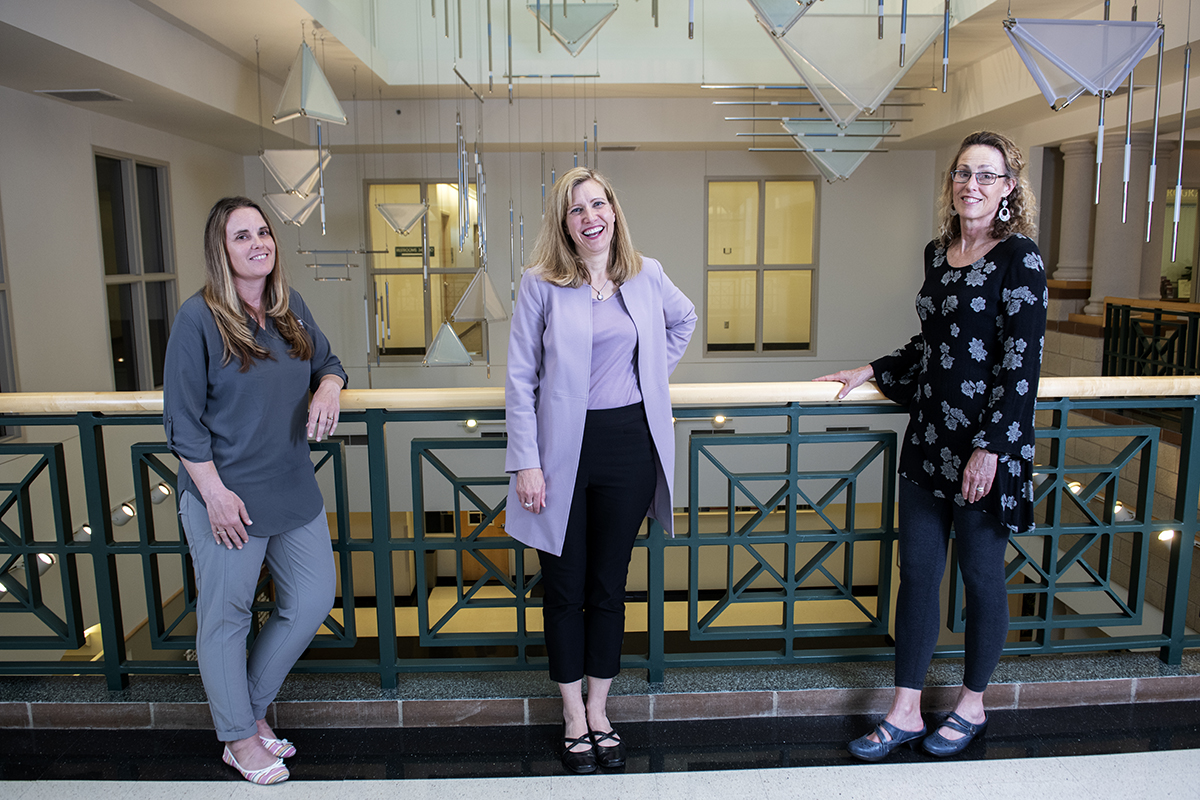- Editorial Offices
- 203 Brantly Hall
- Missoula, MT 59812
- (406) 243-2488
- themontanan@umontana.edu
Ahead of the Data

Predicting the demise of business schools and their graduate offerings has become a cottage industry. Forbes ran a piece in August 2019 proclaiming “It’s Official: the MBA Degree is in Crisis,” following its explication of “The Demise of the Full-time MBA” the year before. It trailed by a longshot James Fallows, who in 1985 wrote in The Atlantic, “Alert to the workings of supply and demand, some business-school officials have predicted a glut; already, newer, weaker schools have been retrenching, and some recent graduates have settled for less attractive jobs than they might once have hoped to get.”
While it’s true that for the past two years MBA programs nationwide have seen a decline in applications, these numbers have contracted in the past, only to expand again later.
The business school seems to abide as a fixture on our academic and economic landscape. The UM College of Business demonstrates how an educational institution can survive trying times by focusing on fundamental and cutting-edge curriculum at the same time. UM’s COB has been evolving in both course and degree. In 2016, the school debuted a new degree program, a Master of Science in Business Analytics, in part as a response to the yawning lack of data scientists nationwide. (In 2018, IBM predicted the U.S. would see 700,000 additional data science job openings within 24 months.)
But the process of building a university degree can be time-consuming, so the COB delivers fresh content by offering innovative instruction on the individual course level. The college partners with leading businesses to examine how they navigate rapidly changing markets.
The latest rendition is a popular Digital Media Ecosystems class co-taught by executives from LumenAd, a Missoula-based advertising media management platform that was No. 29 on the Inc. magazine’s list of the 5,000 fastest-growing start-ups in the country. The college also piloted a 15-hour weekend course this past March titled “Pillars of Profitable Ecommerce” taught by Jacob and Dr. Eulalie Cook, owners of Tadpull in Bozeman, which builds artificial intelligence tools for e-commerce companies.
Gleaning real-world insights from professionals at LumenAd, Tadpull and other fast-growing companies provides invaluable benefits to UM students. Companies like these are interested in partnering with the COB to hire UM’s graduates.
Eulalie Cook says, “The MSBA program does an exceptional job preparing students to compete in today’s modern, data-driven economy. To our knowledge, there are no universities offering classes that focus on the sweet spot of customer lifetime value, digital marketing campaigns and inventory and operations. The opportunity to offer this cutting-edge course at UM is so exciting.”
A matter of balance
A central tension animates any question about the role of a professional program like a pharmacy or journalism program – or a business school: How do you instill fundamental educational concepts and still tailor the content to help students find jobs, all in a limited amount of time?
It is, according to Dr. Suzanne Tilleman, interim dean of the College of Business, a mission with balance.
“We take students with innate work ethics, and, through transformative learning experiences, we help them achieve a better life,” Tilleman says. “A better life for us usually means access to launching their career.”
But it’s not exclusively that,” she says. “We do have students who take business principles and concepts and apply them to other efforts beyond just their careers. We really are focused on getting students jobs. For some students that means high-paying jobs, and for some it means changing the world in other ways that matter to them.”
The business college relies on various data sources and tools to track broader trends in jobs to inform curriculum adjustments. The new MSBA program, for instance, is a recognition that understanding how to sift through data to spot actionable business insights has become a highly sought-after skill set. Still, training students for a future powered by analytics is not as simple as teaching them different ways to crunch numbers. It’s also teaching them a way to think about doing business.
“What we found in the MSBA is that our students have really strong technical skills but are not familiar or practiced in making the business recommendations based on their analysis. Or we have students who are very strong in understanding how to make business recommendations but need to scale up on the technical aspects,” Tilleman says.
A competition of ideas
Big changes are usually slow events at a university. There are protocols, and committees and accrediting bodies may hamper agility. Against a rapidly changing business landscape, nobody ants to trot out a degree program only to find they’ve burned months and money while the world is already onto the next new shiny thing.
Once the COB decided to create an MSBA, Regents Professor of Marketing and the Poe Family Distinguished Faculty Fellow Jakki Mohr led the charge from the faculty perspective. Mohr spent time in Silicon Valley at Hewlett Packard in the 1980s before returning to academia and earning her doctorate at the University of Wisconsin, where she published a dissertation on the disintermediation that had upended the personal computer age. Her academic career has continued to examine the disruptive forces the technology market faces, and how that ripples outward.
“What we recognized about five years ago was that if our students weren’t really skilled in marketing analytics and digital media platforms, they were going to find it really tough to compete,” Mohr says.
Any university is a collection of ideas and methodologies competing for student attention and, well, budget. Launching a new course of study in the face of tight budgets can be a struggle. Mohr worked with her faculty committee to build a robust degree program that incorporated existing resources. She and other faculty reached out to the computer science department to offer a course in machine learning and neural networks. They partnered with the math department to incorporate a course in advanced statistical tools. Mohr also leaned heavily on the COB advisory council — all real-world business professionals — to identify skill sets that span verticals.
“Our students definitely are going into a job market that is changing in real time,” Mohr says. “But they’ve got the aptitude and the skills to compete favorably. We’re partnering pretty closely with companies who have helped us refine our curriculum to make sure that we’re staying on the cutting edge.”
New ways to tell stories
In creating the MSBA degree, the business college understood that aspects of that program could filter into all corners of the curriculum. John Chandler, UM clinical professor, who teaches a class called “Telling Stories With Data” and who helped Mohr develop the MSBA,
explains why.
“We no longer have this world divided into jobs that are not quantitative and jobs that are quantitative,” says Chandler, who holds a doctorate in mathematics from UM, teaches for half the year and runs a data consultancy during the other half. “There are quantitative aspects to all jobs,” he says.
Data, Chandler thinks, is not going away any time soon, but methodologies will evolve rapidly. In his teaching, Chandler has tried to impart ways to think about how data can help do business better.
“We can’t chase the next shiny thing. We have to try to apply principles and knowledge and ways of thinking that pervade the University and help translate skills into the business world,” Chandler says. “We spend a lot of time writing code or doing fancy statistical techniques, but every analytic question starts with some sort of business question. Refining your question is one of those skills that’s transferable in a lot of different areas.”
Stand and deliver
If teaching a college course is a little bit of science and a little bit of art, figuring out how to deliver a new master’s program is pretty heavy on logistics. That job fell to Dawn Hambrick. After graduating from Montana State University, marrying her high school sweetheart and earning a master’s degree through distance learning while accompanying him throughout his military career around the country, Hambrick came home to the Bitterroot Valley, where she had grown up.
Though not a professor, Hambrick oversees the administrative details of the program and much of the marketing and budgeting. “I work with the dean to make changes, but all of this is done as a team,” she says.
“If Jakki [Mohr] feels a curriculum change should be made, I take it to curriculum committee, and [if approved] implement that change. We collaborate to make changes.”
One change immediately made by Hambrick, herself a student of online coursework, was the way courses in the MSBA program could be consumed. “We took it to the more flexible delivery option. It tripled our enrollment in the program,” Hambrick says.
Around the country most MSBA programs are taught in face-to-face class settings. “In this region, we found it difficult to deliver that way,” Hambrick says. “People want to advance their careers but can’t afford to move to Missoula for two years to do it.”
Previously, the MBA program offered remote work, but students had to go somewhere specific – a community college or designated computer lab – to watch the lectures. Hambrick made adjustments so now streaming services allow students to partake in classes on their laptops and interact from wherever they are.
The COB now delivers graduate program coursework literally around the world, but the core teaching remains close at hand. Wherever its teachings are consumed, the real job of the business school, Tilleman says, is to create a setting where students can take risks.
“When they take a risk or a stretch, the students experience growth,” Tilleman says. “They have to make changes. They have to make decisions that then help them grow, and they get to a next level where they can start learning more new concepts, new ways of applying them and new ways of interacting with people.”
Which sounds exactly like the model the UM College of Business has followed for years.





